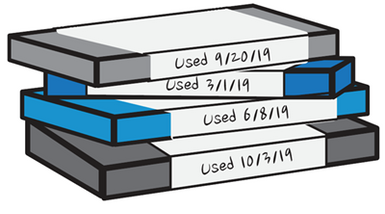Posted by Chrom Tech on 28th Oct 2025
How To Regenerate a C18 HPLC Column
By Chrom Tech – Your Chromatography Consumables Partner Since 1983
How to Regenerate a C18 HPLC Column
Proper regeneration and cleaning are essential to extend the life of your HPLC columns and maintain consistent performance. Regular maintenance removes accumulated particulates, salts, and strongly retained analytes that can lead to pressure build-up, poor peak shape, or reduced efficiency.
Standard Regeneration Procedure for Reversed-Phase Columns
For columns that can be backflushed (typically those with reversed-phase particles >1.8 µm), follow this cleaning sequence using increasingly strong solvents. Always direct waste into a collection vessel and ensure system pressure limits are not exceeded.
- Disconnect the column from the detector and divert flow to a waste beaker.
- Flush with 10–20 column volumes of mobile phase without buffer salts (e.g., water/organic mixture).
- Rinse with 100% organic solvent such as methanol or acetonitrile.
- Check system pressure—if it returns to normal, the regeneration is complete.
- If pressure remains high, use a stronger solvent mixture (75% acetonitrile / 25% isopropanol).
- For persistent contamination, flush with 100% isopropanol, methylene chloride, or hexane. Note: If methylene chloride or hexane is used, follow with isopropanol before returning to the reversed-phase mobile phase.
Important: For columns with sub-2 µm particles, do not backflush. Replace the column to prevent bed disruption and irreversible damage.
Column Regeneration Quick Reference Table
| Column Particle Size | Backflush Allowed? | Initial Solvent | Intermediate Solvent | Strong Solvent (if needed) | Notes |
|---|---|---|---|---|---|
| > 1.8 µm | Yes | Mobile phase (no buffer) | 100% Methanol or ACN | 75% ACN / 25% IPA → 100% IPA / Methylene Chloride / Hexane | Flush with isopropanol before switching back to aqueous mobile phase |
| < 1.8 µm | No | Replace column – backflushing not recommended | |||
Storage Recommendations for Reversed-Phase Columns
After regeneration, proper storage protects column integrity and ensures reproducibility in future runs. For silica-based bonded-phase columns, store in a pure organic solvent such as acetonitrile.
- Purge the column with 20–30 column volumes of a 50:50 methanol/water mixture to remove buffer salts.
- Follow with 20–30 column volumes of 100% organic solvent.
- Seal both ends tightly using end plugs to prevent drying.
To safeguard your HPLC system, remove any residual buffer salts from both the instrument and column by flushing with a non-buffered mobile phase (e.g., 60:40 ACN/H₂O instead of 60:40 ACN/0.02 M phosphate buffer). This prevents corrosion and reduces equilibration time before the next use.
Use a Standalone HPLC Pump for Regeneration
Free up your main analytical system by using a standalone HPLC pump for column regeneration and flushing. This setup allows maintenance without disrupting sample analysis and can be automated for overnight operation with a solvent selection valve.
Chrom Tech offers cost-effective HPLC pumps, HPLC accessories, and stainless-steel tubing assemblies to support column cleaning workflows. For advanced regeneration advice, contact Chrom Tech’s technical team for personalized recommendations.
Frequently Asked Questions
Why should I regenerate my HPLC column?
Regular regeneration removes particulates, strongly retained analytes, and salts that can degrade performance, helping extend the column lifespan and reduce replacement frequency.
Can all HPLC columns be backflushed?
No. Only reversed-phase columns with particle sizes greater than 1.8 µm should be backflushed. Sub-2 µm columns should not be backflushed to prevent damage.
Which solvents are recommended for column regeneration?
Begin with the mobile phase without buffer salts. If needed, proceed to 100% methanol or acetonitrile, followed by stronger solvents like isopropanol, methylene chloride, or hexane (ensuring appropriate flushing afterward).
How should columns be stored long-term?
Store silica-based C18 columns in a pure organic solvent such as acetonitrile. Remove buffers beforehand and seal both ends tightly to prevent drying.
Can I regenerate columns without using my main HPLC system?
Yes. Using a standalone HPLC pump allows independent regeneration and storage preparation, preserving valuable analytical time.

